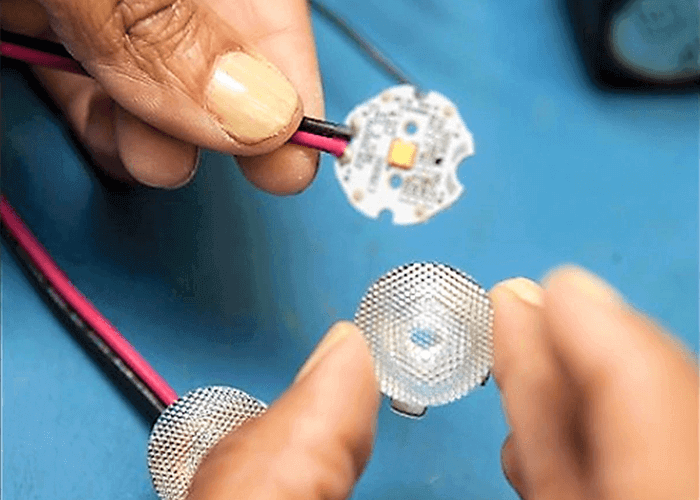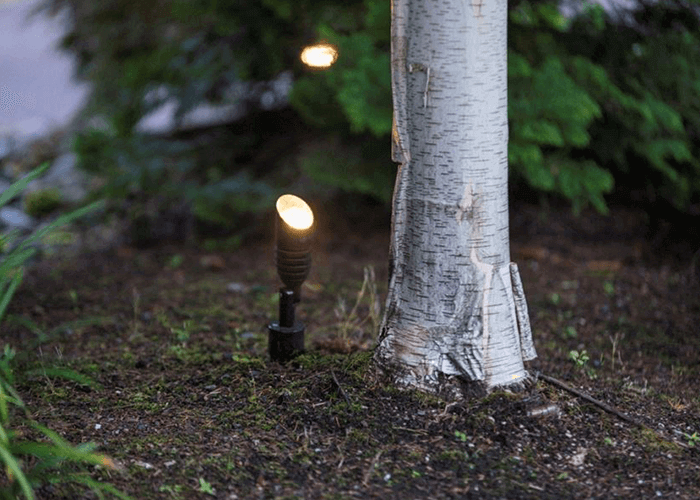What Is LED Outdoor Lighting?
LED (Light Emitting Diode) lights are currently all the rage for everyone from car drivers to homeowners. These lights, which typically use 75% less energy with a minimum of 25 times the longevity, have become the light source du jour for so many of our clients. LED is still a rapidly advancing technology and will bring a substantial savings to the US energy demand as well as your personal home energy savings. However, we have found that there is still a great deal of confusion and uncertainty about these lights, so we wanted to share information that could shed some light on the subject (pun intended!).
LED bulbs have the following components
- LED. A Light Emitting Diode (chip) is a flake of metal that has a specific amount of energy delivered to it by a small computer board (driver) that is designed specifically for it. A higher quality chip will eliminate fracturing which gives a rainbow effect, something you don’t want in your light fixtures! Great LED fixtures will give you a clean output with no hot spots, color separation or sharp edges.
- Driver. Drive systems manage the energy flow to the LED. A great driver will be housed away from the LED board in order not to share its heat. A driver should have the capacity to correct fluctuating power for a smooth, consistent flow which will save your LED board from surges.
- Housing. It’s crucial that the housing allows a majority of the heat to escape, is durable and weather resistant to last the life of the LED.
- Optics. LEDs need optics to deliver the concentrated amount of light in a specific direction. Optics are very important and can give you a variety of beam widths.
- Color tone or Kelvins (K). The range of Kelvin lets you know the light the LED will produce. We use an almost exclusively warm white, which is between 2700 and 3000 Kelvins. This light color produces the look of the lighting in your living room versus the light in your workshop. True color LED fixtures use a RGB (red, green, blue) chip, NOT a white light through colored plastic discs.This gives you the best and strongest colored light.

How LEDs Are Different (sourced from www.energy.gov)
LED outdoor lighting is very different from other lighting sources such as incandescent bulbs and CFLs. Key differences include the following:
- Light Source: LEDs are the size of a fleck of pepper, and a mix of red, green, and blue LEDs is typically used to make white light.
- Direction: LEDs emit light in a specific direction, reducing the need for reflectors and diffusers that can trap light. This feature makes LEDs more efficient for many uses such as uplights and reflective lighting. In other types of lighting, the light must be reflected to the desired direction; as a result, more than half of the light may never leave the fixture.
- Heat: LEDs emit very little heat. In comparison, incandescent bulbs release 90% of their energy as heat and CFLs release about 80% of their energy as heat.
- Savings: LED lighting will provide a savings of 75% compared to incandescent lighting energy costs.
LED Outdoor Lighting Integrated Fixtures vs. Replacement Bulbs
Many clients simply want to replace their existing halogen bulbs with LED bulbs. While this may sound like a quick and easy way to incorporate LEDs into your existing lighting scheme, homeowners seeking to upgrade their lighting system to LED need to understand how LEDs are engineered. The heat created by the bulb will start to deteriorate the LED board and your “20 year” bulbs will fail faster and also delaminate, providing a variety of colors that you may not want. Clients should consider upgrading the entire fixture from halogen to LED.
A common misconception is that LED fixtures are difficult to install. Actually, they can be somewhat easier. All the parts are joined together, with the components integral to the fixture. The bulb is integrated, not loose, and the optics are integrated (the wiring as well).
Additionally, LED outdoor lighting is cooler to the touch. A typical halogen fixture produces 300 degrees, whereas an LED can top out somewhere in the 90 degree range.
Further, LEDs are manufactured in a way that disperses heat correctly from the diode. As little as this may seem, it is significant to the board that operates the LED and its components. As a result, LED outdoor lighting should be integrated fixtures.
Also, even if you purchased a bulb or fixture that promises to last 20 years, is that a true illumination or just a glow? After all, the highest wattage available for LED bulbs is only 20 watts. Most tall trees and dense shrubbery need at least 35 watts to illuminate properly – so upgrading your bulbs without the proper fixture may actually decrease your brightness.
Further, Electro Magnetic Interference (EMI) can affect operation of LED bulbs. As a result, placing bulbs in the vicinity of electric garage openers or gates is not recommended. Are your outdoor lights properly set away from electromagnetic interference? If not, merely swapping your halogens for LEDs will not have the desired effect.

The better option is to replace the whole halogen fixture with an LED fixture designed for landscape lighting. LED fixtures are engineered for outdoor use and operate equally as efficient in wet or dry locations. They are also designed for a wide range of heat & cold climates. Color tone remains consistent for the life of the product. A high quality product will have less than 15% reduction in light output over its lifetime, something which cannot be detected by the human eye. There is no UV damage that occurs in a quality LED Outdoor Lighting fixture, and a large heat sync reduces operating temperature resulting in longer life. LED outdoor lighting fixtures are specifically designed to eliminate failure by placing the driver away from the heat source. EMI protection is also built into the LED fixture to protect against electrical interference.
In addition to all of this, you want to be sure that once you replace your halogen fixtures with LEDs, you get customer service and support you need. All products have issues; LEDs are no different. Should an LED outdoor lighting fixture fail, your installation team should have replacement parts readily available, or the fixture should be under warranty should it need to be replaced.
What we’re basically saying is that LED outdoor lighting fixtures can replace an outdated halogen system and offer superior reliability, reduced servicing and maintenance, and provide color tone correctness – all in all, a better fixture for the wear and tear of the outdoors.
We pride ourselves on our ability to work with our clients to help them understand LED lighting systems and install the best system possible. We’d love to work with you to see how we can help you use LEDs to light up your property! Give us a call!





